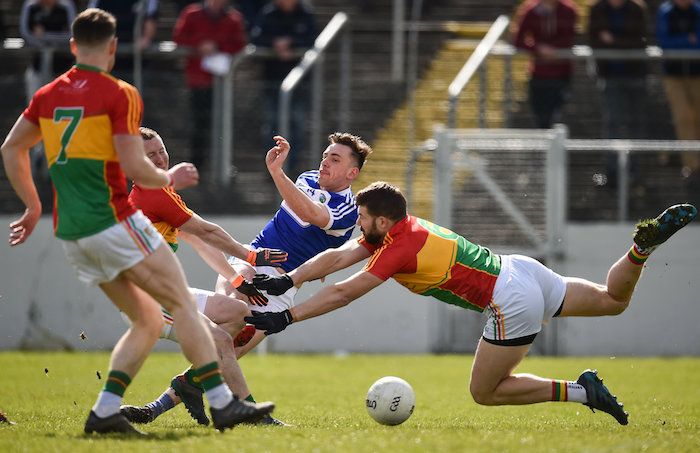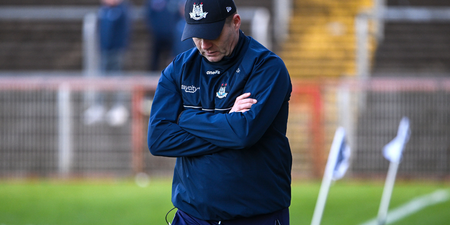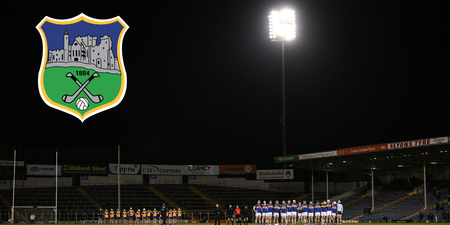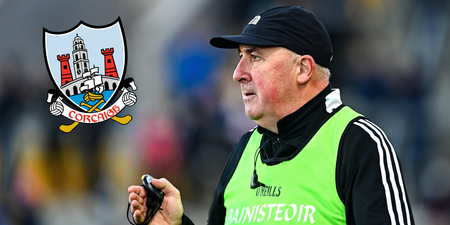“We came down here and we knew who we were facing. The game against Dublin last year showed you that and they haven’t changed a whole lot since.”
Laois manager John Sugrue talking after Laois edged out Carlow in a dour game of football on Sunday.
The most interesting part of the above quote is that Laois knew what they were facing.
Last year, Carlow had a great run in the championship playing a very defensive brand of football. They frustrated Dublin for a while but lost by 12 points, beat two Division Four teams and had their best performance against Monaghan where they lost by five.
This year, not much has changed tactically and they have got a bit of media attention but the secret is now out. John Sugrue’s Laois team went to Dr Cullen Park on Sunday and were tactically clued in.
Carlow scored one point from play in 75 minutes of football.

Galway are another team using the ultra defensive tactics and have had a great league. They are still using the element of surprise with teams not prepared to face the level of defensive tactics Galway are employing. Teams experiment during the league and I’m sure opposing managers were not quite sure Galway were committed to this style of play.
However, the secret is out now too and I’d imagine Galway will have a frustrating league final and championship as opposing teams are better prepared for what they are facing.
Ultra defensive tactics will have some short term success but they’re regressive and one dimensional. They depend almost entirely on the opposing team pushing up and forcing the play, giving them the turnovers they require. As Dublin showed last year, when embarrassing Tyrone, if you’re patient and don’t bring the ball into contact, these defensive tactics look very ordinary. As we have seen, when they came up against tactically astute teams and managers that mirror their system, they struggle.
Jim McGuinness brought this system into the word of Gaelic football in 2011. He had the element of surprise for almost four years, beating teams on the counter attack. He won the All-Ireland in 2012 beating Kerry, Cork and Mayo, crowding the defense, turning the ball over and hitting them all on the break. His tactics were copied by many counties and surprisingly still are.

It continued until 2014 when they shocked a tactically naive Dublin management and destroyed the Dubs who pushed up all over the field.
Eamonn Fitzmaurice was watching and mirrored Donegal’s system in the final and beat them.
Tyrone have had success in Ulster with the system but have not beaten any team rated higher than them in the championship using these tactics in four or five years.
The secret has been out on Tyrone a while now.
Tyrone legend Sean Cavanagh waited until he was out of the Tyrone bubble to voice his opinion on their defensive system. He tweeted after a loss to Monaghan in the league this year.
https://twitter.com/SeanCavanagh14/status/967499316226068483
The extent to which it is a one dimensional gameplan can be seen when you look at Carlow coach, Stephen Poacher’s coaching.
Below is a coaching plan based on “Developing Offensive Transition Play” which he gave to Skerries Harps.
- Triple Transition Scoring Game
- Multiple Re-Start Transition Game
- Drop Down and Drive Transition Game
- Kick and Transition Game
- Run it or Kick it Transition Game
- Blast off Transition Game.
Don’t be concerned if you don’t understand any of that, I don’t either, but I’m fairly sure it’s based on what you do when your team turns over the ball and how you transition from defence to attack.
Now all this gobbledygook might look impressive to club administrators, who don’t know any better, but you’d have to wonder where all these wonderful transition moves were on Sunday when Carlow only scored one point from play in the entire game.
Like I said above, all this means nothing if the opposing team is tactically astute and doesn’t give up the turnovers needed. And if they do give up a turnover, which inevitably will happen in a game, tactically astute managers will have a few players back minding the defence and will have his players well drilled and disciplined to track the runners.
When I hear these defensive teams are ‘well-organised’ in defence, I cringe.
How difficult is it to organise 14 players in a confined space inside your 45′? I’ll take a guess and say you have six marking the opposing six forwards and seven extra outfield players on either side with some placed zonally and others drifting across to the side the ball is on.
Doesn’t sound too difficult to me but maybe I’m getting old and out of touch.
Now we see teams patiently playing the ball around outside the 45′ and the defensive team looking silly just standing inside waiting for them. The onus is on them to come out, especially if they’re behind. If I was Laois manager and was five points up against Carlow like on Sunday, I’d tell my players to play the ball around in their own half until Carlow came out to play.
Yes the crowd will jeer but the jeering should be reserved for the team that didn’t come to play ball.
Interestingly some current players, while being respectful to their team and management, have been giving us subtle hints about how they enjoy playing like this.
Sean Armstrong was asked recently on TG4 what the Galway players made of their new defensive shape. He said with a smile, “we don’t mind it when we’re winning’.
Carlow’s Paul Broderick told the Carlow Nationalist:
“If we were losing and we are playing a system where you’re not getting much ball, it’s easy to throw the toys out of the pram. The fact that we are winning… would I like to be on the ball more? Yeah. But the system is working”
Players seem to be putting up with these dour, outdated tactics because both Carlow and Galway are having some relative success at the moment.
But now both of their secrets are out so unfortunately, as the opposition are adapting, we can expect some ‘games of chess’ or ‘tactical battles’ involving these teams this weekend and during the summer.
Can’t wait.



















































